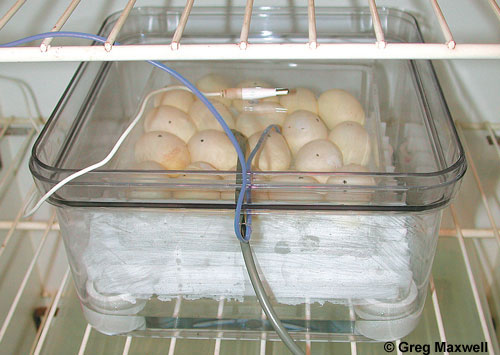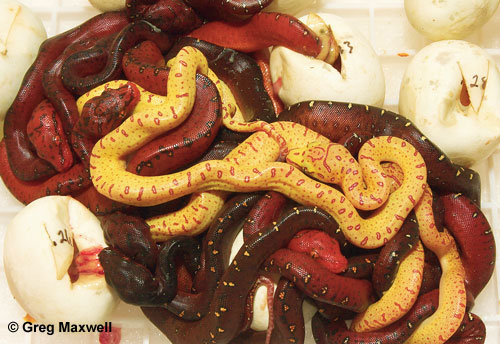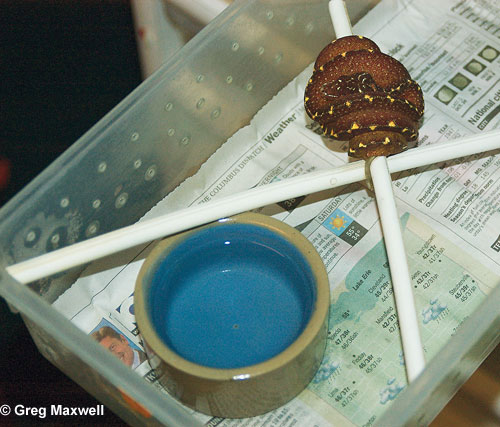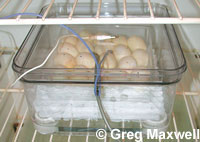How to breed the green tree python.
Breeding Green Tree Pythons
Consistently reproducing green tree pythons in captivity is a challenge. Female green tree pythons need to be at least 3½ years old and at least 2 pounds; male green tree pythons sometimes are willing to breed when 2½ to 3 years old. Candidates for breeding should be healthy and well-conditioned with good body weight and muscle tone.

Photo Credit: Greg Maxwell
The author prefers to artificially incubate clutches in a water substrate setup. Probes monitor the incubator and egg surface temperature.
The reproductive season begins with thermal cycling. Drop the nighttime cage temperatures into the upper 60 degrees Fahrenheit. Begin with a gradual drop, and work down to about 68 degrees. There is no hard-and-fast rule for length of cycling before introductions; I usually cycle for a minimum of two to three weeks before placing the male green tree python with the female green tree python.
It is important to return cages to normal average daytime temperatures of 84 to 86 degrees throughout the cycling period. I maintain nighttime temperature drops until the female ovulates. Then I return her to 24-hour heat. Males can be returned to nighttime heat once they are no longer needed for breeding that season. I cycle my snakes once annually, but the length of time is not fixed. It depends on the snakes’ breeding activities and progress.

Photo Credit: Greg Maxwell
Baby chondros can be yellow or maroon. Mixed clutches are possible depending on the parents' colors when they hatched
Compatible adult green tree pythons usually copulate the first night after pairing, and copulation can last well into the following morning. The pair may breed for several days and then rest. I feed females throughout the cycling and breeding period until they go off-feed; males refuse food as soon as cycling commences if not sooner.
Green tree pythons normally copulate for four to six weeks. If all goes well, the female begins to swell with developing egg follicles, and the male loses interest in her. She begins to refuse food at this time. Four to six weeks after going off-feed, the female ovulates. This is marked by a 48-hour swelling and restless posturing. Females have a pre-lay shed about 25 days after ovulation and 14 to 21 days before egg deposition.

Photo Credit: Greg Maxwell
Green tree python hatchling enclosure
Female green tree pythons should be given a dry nestbox in which to lay eggs. You can allow the female to brood her eggs, but most breeders these days use artificial incubation to hatch eggs. This allows a much faster recovery for the postpartum female. Clutch sizes range from 10 to 30 eggs, but 20 is about average. Incubated at approximately 87 to 88 degrees, eggs take about 50 days to hatch.
Set up green tree python neonates in individual plastic tubs and keep them well-hydrated until they shed, which is normally 10 days after hatching. Babies are not easy to establish and must be tease-fed small pinky mice scented with chick down often. Once they catch on they are little chowhounds and feed aggressively.
The importance of obtaining domestically captive-bred green tree pythons cannot be overstated. Much of the reputation these beautiful pythons have for irritability and difficulty stems from experiences with imported specimens, which seldom thrive or breed in captivity. Although green tree pythons are not the easiest snakes to keep, they are well worth the extra effort. I wish you success with your snakes!



